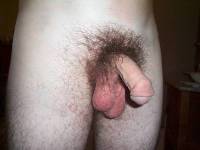Chordee
| Chordee | |
|---|---|
 | |
| An uncircumcised human penis with chordee. | |
| Pronunciation | |
| Specialty | Urology |
Chordee is a condition in which the head of the penis curves downward or upward, at the junction of the head and shaft of the penis. The curvature is usually most obvious during erection, but resistance to straightening is often apparent in the flaccid state as well. In many cases but not all, chordee is associated with hypospadias. This is not the same condition as Peyronie's disease, which involves curvature of the shaft of the penis most commonly due to injury during adult life.
Signs and symptoms
It is usually considered a
The curvature of a chordee can involve[citation needed]
- tethering of the skin with urethra and corpora of normal size;
- curvature induced by fibrosis and contracture of the fascial tissue (Buck's fascia or dartos) surrounding the urethra;
- disproportionately large corpora in relation to the urethral length without other demonstrable abnormality of either; or
- a short, fibrotic urethra that tethers the penis downward (the least common type).
Severe degrees of chordee are usually associated with hypospadias, but mild degrees of curvature may occur in many otherwise normal males. When the curved penis is small and accompanied by hypospadias, deficiency of prenatal androgen effect can be inferred. [citation needed]
Cause
A chordee may be caused by an underlying condition, such as a
Treatment
The principal treatment of chordee is surgery in infancy,
